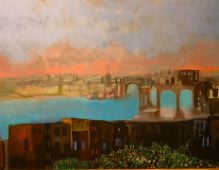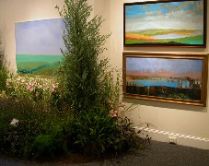Hi there, still in California, but thought I’d touch base today and post my Weekly story — a review of Sande Webster Gallery’s summer group exhibit. Here’s the Weekly link. And here’s Libby’s post on the show.
Flower Power

Every summer in recent memory gallerist Sande Webster has organized a provocative show dealing with contemporary issues. One summer the show’s theme was black and white. The work was in that color scheme, and not far from the surface was the issue of race relations. Another summer the show was urban photographs, and programming included a public forum in the gallery that dealt with gun violence. (image is detail of painting by James Brantley. Note the mini-garden in the foreground.)
But this summer the gallery is full of art that addresses the least controversial subject of all: flowers.
When I stopped in to see the show-lyrical, quiet and lovely-Webster told me she needed a respite from the real world. Enough urban blight, war and violence. Bring on the daisies.
In a show called “The Garden Is Art/Art of the Garden,” the gallery has organized prints, photographs, paintings and sculpture on Edenic themes. In another move that gives your nose an unexpected treat, Webster brought in real flowers and plants-thick mini-gardens of black-eyed susans, ferns, lilies, small shrubs, lavender, grasses, arbor vitae and miscellaneous posies and tendrils in arrangements designed by John Baliski. The flora happily complements the art and doesn’t compete.
The sprawling show occupies the gallery’s front-corridor spaces as well as the main gallery. With all the buds in the back gallery, it’s a wonder the paintings and other art look as good as they do.

But the landscape paintings by James Brantley, with their unexpected colors and uncompromising compositions, hold their ground. Other highlights in the painted realm include Ian Jarvis’ Loss of Blood, a large painting of a red flower with drip lines that look like trails of tears. (installation shot of the show)
Susan Howard’s small, busy landscapes with birds and elephants in a happy primordial Eden soup are a lovely addition. Karl Howard’s wire animal sculptures add some whimsy, and Steven Donegan’s copper planters are elegant and beautiful.

Work in the large outer corridor, mostly photography, hints at nature’s darker themes-decay and death. There’s a black-and-white photo by Andrea Baldeck (Dandelion #1) that signals the end of a flower’s life, and Joanne Watkeys’ photograph Cradle highlights solitary moments in a plant’s life cycle-like when there’s just one berry left on the vine. Photographers Ron Tarver, Arlene Love and Michael Froio add weight with painterly photographs of trees, the woods and other natural pleasures. (detail of bronze sculpture in the garden show. I don’t have the sculptor’s name here but will add it when I get my computer and my notes together)
Not so long ago, beauty was banished from the art table, dismissed as sheer retinal pleasure by those who preferred meatier fare like concepts or formal conceits in their art. Now beauty is back in play, allowed to be a valid art concern-and why not?
This show, so clearly a response to the need for beauty in the world, isn’t going to shake things up or define new ground in art. But it sure is a welcome exhibit, and one that took some risks-bringing those real-world beauties inside with the painted, photographed and sculpted ones.
In a way the show’s a nice complement to the outdoor exhibit “Passages” at Abington Art Center, which takes art and places it outside in nature. Both shows are good examples of weaving together the natural and the man-made-and both are great summertime viewing.
“The Garden Is Art/Art of the Garden”
Through Aug. 26. Sande Webster Gallery, 2006 Walnut St.










